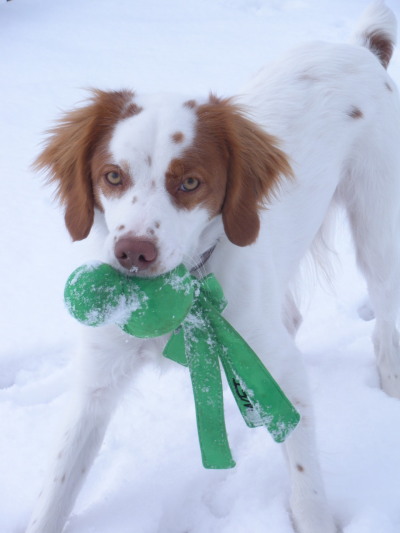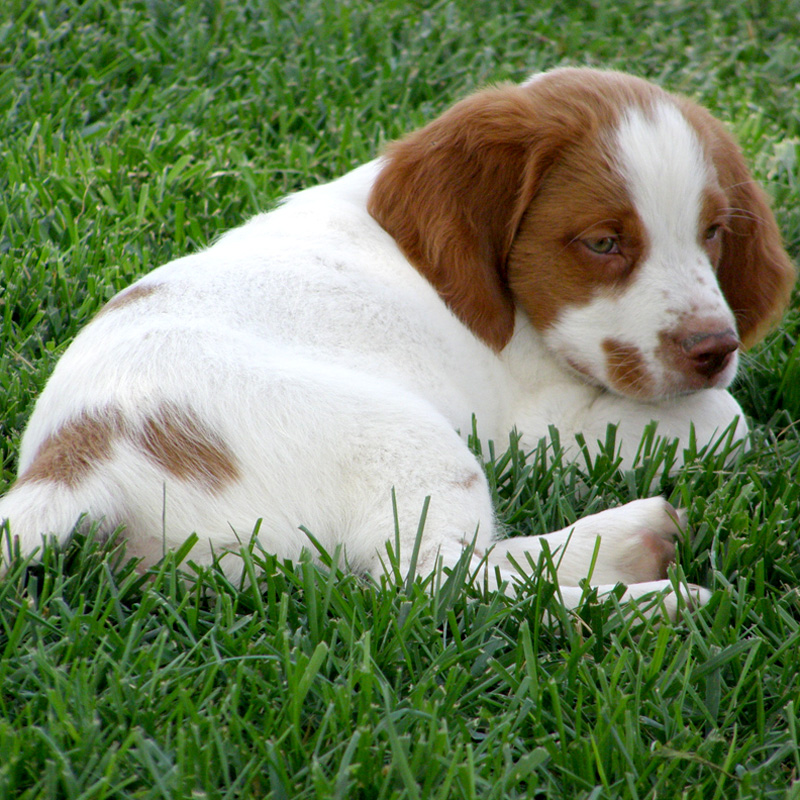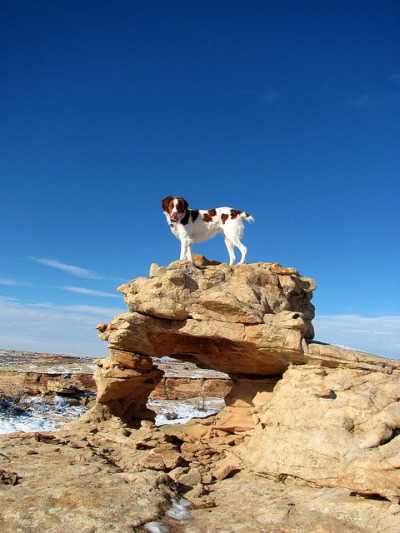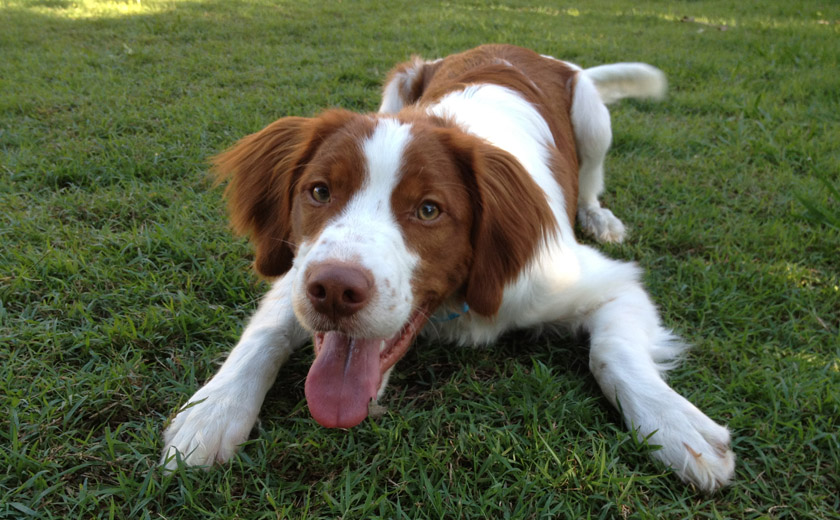
Brittany dog
Brittany dog is intelligent hunter, Brittany breed dog has small size, Brittany dog has excellent intuition.
The name comes from the French province of Brittany, which first appeared in this breed. From 1934 to 1982 it was registered in the American Kennel Club as a Breton Spaniel, though the manner of operation looked more like a setter. In appearance Breton less setter, but vysokonog more than a spaniel's tail is short, ears are planted relatively high. On September 1, 1982 the breed received official status in the AKC as Breton.
Most experts believe that all dogs, hunting small game, have a common ancestor, although data on the development and dissemination of various hunting breeds are lost for centuries. Early written records do not reveal the origin of Breton. They are referred to as Brittany and Britain, the latter probably relates to the British Isles, than to name the French provinces as Brittany to the V century BC. er. was known as Armorica. Appiah, who lived in the II century, wrote about the barbarians of Brittany (or British?), Noting that their dogs had a flair much better than others. This quality of many Breton continues to this day.
It is likely that dogs are Brittany and Wales had a common ancestry and similar paths of development. These two areas are geographically close to ancient times and are actively traded with each other. Need only look at modern velsh Springer Spaniel and Breton, to note their similarities.
The first source, reliably indicate Breton - paintings and tapestries of the XVII century. The consistency with which the images of these dogs, said that they were quite common. Audrey (1686-1745) paints a liver and white dog in a rack over a partridge. Equally typical images of artists of Flemish school of painting by Jan Steen, is common in Breton and other paintings. Therefore, the ancestor of Breton - not uncommon on the northern coast of France, Holland and Germany, where he came from German vahtelhund (Deutcher Wachtelhund) - modern rock, the appearance and working qualities reminiscent of Breton.

Brittany dog
Brittany dog is a good hunter, Brittany dog is fast and easy trained dog.
Legend has it that the first ancestor of the modern scanty Breton was placed approximately in the middle of the XIX century Ponte, a small town situated in the valley Dyuron, as a result of crossbreeding with white patches of mahogany bitches local hunter and a lemon-white male, was brought in Brittany English hunter woodcock. Of the two scanty puppies that have emerged in the litter, only one left. It worked perfectly in the field, and therefore became a popular manufacturer. Puppies in all its litter or do not have a tail, or were born with short tails-stumps.
Until 1850 there was no written evidence concerning this breed. In 1850, Reverend Davis described the shooting in Carhaix with small short-tailed dogs with longer hair than the Pointer. They worked well in the bush, did stand over the game, they brought game and enjoyed very popular among poachers, because the very nature of this profession requires a docile dogs. Description of these dogs is fully consistent Breton.
There have been suggestions (to confirm at least once), in Brittany at the turn of the XX century is often tied to local Spaniel English Retriever, which brought fans hunting for woodcock. The result is believed to have Bretons entrenched ability to stand, although their appearance has remained the same. Breton, as the breed was recognized in 1907, when the orange-and-white dog fight was registered as the first I'epagneul Breton (queque courts naturelle) [Brittany Spaniel (with a naturally short tail)], the breed name was soon shortened to I'epagneul Breton. Until 1907 Breton included in the "mixed class" French spaniels, but then was adopted by the first breed standard, which required that the tail was short at birth. Later, the requirement of congenital korotkohvostosti been omitted.
Breton appeared in the United States in 1931 and officially recognized by the AKC in 1934. The first standard, literally translated from French, was rather vague. A significant achievement of the American club of fans of Bretons, founded in 1942, was to develop a clear and explicit official standard, which replaced the old one.
The growing popularity of Bretons in the United States due to their working qualities. Small size, excellent intuition and innate devotion to his master make this dog indispensable for American hunters. Thanks to its size, it is convenient for keeping in the city, and his desire to always be profitable in today's hunting grounds, crossed by numerous roads and fences

Brittany dog
Brittany dog is a good family dog thanks to its size,Brittany dog is convenient for keeping in the city.
Most of the breeders Bretons in the U.S. is trying to breed dogs with good conformation and simultaneously working to preserve quality. The most popular field tests conducted by club Breton and its many affiliates. Interest in the exhibition owners Bretons increased significantly in recent years. For 30 years, more than 150 dogs have won the coveted title of "Double Champion" (winner of the trials of working qualities and at the exhibition).
Breton. Official Standard
Approved April 10, 1990
General view. Compact, well-built dog of medium size, relatively vysokonogaya the impression of a tireless and agile runner. Strong, lively, energetic and fast moving. Strong and powerful addition, but without coarseness - a characteristic feature of this breed. Without a tail or a docked tail length of about 10 cm
Height, weight, proportion, composition. Height: 44,5-52 cm Weight: 13,5 - 18 kg.
Proportions: Dog moderately vysokonoga format - square.
Length of body approximately equals the height at the withers (from humeroscapular joint to point of buttock).
Addition: the backbone of a strong but not powerful and not rude.
Vices: excessive prolixity.
ELIMINATING FAULTS: growth below 44.5 cm or 52 cm above
Head. Expression in his eyes - an energetic, gambling, while soft, like a bird dog. Deep-set eyes, expressive, protected from the branches of bushes bushy eyebrows, since Breton has to work actively in the shrubbery and undergrowth. The muzzle is well filled under the eyes, lower eyelids are dry and do not form pockets, which can get seeds, dirt and dust. Preference for dark eyes, though lighter shades of amber are allowed. Ears are set high - higher than eye level. Broad and triangular, hanging, reaching to the middle of the muzzle, tightly adhering to the head. The ends of the ears, slightly rounded.

Brittany dog
Ears are covered with dense, but relatively short hair, with weak fringe. Skull of medium length, rounded, slightly wedge-shaped. Not deep and not wide, so the head does not look rough, and narrow, not to look easy. The transition from forehead to muzzle well defined. Furrow on the forehead is not marked. Occiput rounded and determined only by touch. Cheeks are rounded. Muzzle medium length, approximately two-thirds of the length of the skull. Length of muzzle measured from the nose to the transition from forehead to muzzle and the skull - from the occiput to the transition from forehead to muzzle. In the horizontal and vertical wedge-shaped snout gradually converges to the nose. Nose reindeer, dark yellowish brown, all shades of brown or dark-pink color. Nostrils dilated, which makes breathing easier and prichuivanie game. Lips dry, tight, upper lip covers the lower jaw, covering the lower lip. Scissor bite.
Faults: Round, protruding eyes, exophthalmia; missing or piteous look; skull "apple", a sharp transition from forehead to muzzle; Roman nose (hook-nosed), hollow nasal bridge, broad, massive, pointed muzzle, two-tone nose or nose-" butterfly (not fully pigmented nose). Narrow nostrils. Moist lips and pendulous Bryl. Overshot or undershot.
ELIMINATING FAULTS: black (anthracite) nose

Brittany dog
Brittany dog has strong feets and short tail, Brittany dog is strong and fast hunter.
Neck, Topline, Body. The neck is medium length, dry - no suspension - and not loaded, strong. Highly placed on a sloping shoulder blades. The topline is slightly reduced from the withers to the tail. Chest deep, reaches to the elbows, not too broad, not round, so as not to impede the movements of the shoulder blades and elbows. Ribs protruding. Deep and broad in proportion to the chest leaves enough room for the heart and lungs. Back short and straight, not weak, not soft, does not sway or roach. The croup is slightly sloped. Flanks rounded, strong, slightly matched. The belly is slightly tucked up, not dropped, and not lean. Loins short and strong. Distance from last rib to the hips - three or four fingers. In a move loin should not sway horizontally, giving back a zigzag motion and thereby wasting energy. The tail is short - up to 10 cm, natural or docked. The tail should not be too long, violating the general equilibrium dog. Set high, continuing to the top line of the back.

Brittany dog
Forequarters. Vanes should not be abruptly issued and to be too far apart - the distance between them two thumbs up, slanting and well muscled, combined with the humerus at an angle of about 90 °. Height at the withers is slightly higher than the croup. Forelimbs when seen from the front set parallel to each other and not too wide - without outwards or clubfoot. Pasterns slightly sloping. The bones of the forelegs are strong, graceful and easy. Dense core - the same flaw as long limbs and lungs. The necessity of harmony between the fortress and the addition of energetic movement. Height from ground to elbow is approximately equal to the distance from elbow to withers. Feet strong, slightly less than a spaniel, arched his fingers collected and thickly padded. Coat on legs - moderate. Perfect foot should be oval, with solid pads. Fifth fingers may be removed.

Brittany dog
Flaws: vertically raised vanes. Too sloping, soft pasterns. Flat, loose, narrow feet.
Hindquarters broad, strong and muscular, with powerful thighs and well bent knee, providing a powerful and free forward movement. Hindquarters: angles hocks are well expressed, but not enough to calcaneus went far beyond the line of the body. Points for direct posed hind limbs are not removed until the referee in the ring will not check the dog in motion. Hocks should not turn to the side. Thighs covered with a dense but not too thick restroom psovinoy, falling to mid-plus. Metatarsus medium length and steep - parallel to each other - when viewed from the side. Must be strong when the judge of their swings. Feet are the same as in forequarters.
Няма коментари:
Публикуване на коментар